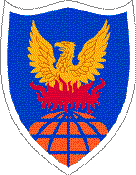Loading AI tools
Military unit From Wikipedia, the free encyclopedia
311th Signal Command Theater is the designated signal command for the Army Service Component Commands within the Pacific and Korean theaters. The staff of 311th Signal Command consists of more than 3000 active-duty soldiers, U.S. Army Reserve soldiers and Army civilians. [citation needed] Headquartered at Fort Shafter, Hawaii, the 311th SC(T) and its subordinate units are stationed across 16 time zones, ranging from Alaska to Korea, and from Hawaii to California.
This article has multiple issues. Please help improve it or discuss these issues on the talk page. (Learn how and when to remove these messages)
|
| 311th Signal Command (Theater) | |
|---|---|
 Shoulder Sleeve Insignia | |
| Active | 1944 - Present |
| Country | |
| Branch | |
| Role | Theater Signal Command |
| Part of | United States Army Pacific |
| Garrison/HQ | Fort Shafter, Hawaii |
| Colors | Blue, Monarch Orange |
| Engagements | World War II |
| Commanders | |
| Current commander | Brigadier General: Ray Phariss |
| Insignia | |
| Distinctive Unit Insignia |  |
The 311th Signal Command originated in 1944 as the 3112th Signal Service Battalion at Fort Monmouth, NJ, supporting Allied efforts during World War II. The 3112th participated in campaigns in Normandy, northern France, Rhineland, Ardennes-Alsace and central Europe. The 3112th Signal was reorganized multiple times until it became the 311th Signal Group in 1952 as part of the Organized Reserve Corps. Due to growing requirements within the Army, the 311th was identified to become a general officer and a theater-level command with the subsequent designation as the 311th Signal Command (Theater) at Fort Meade, Md., in 1996. Ten years later, in September 2006, the 311th SC (T) was reorganized to become the 311th Signal Command and relocated to Fort Shafter, Hawaii to become a theater enabling command of U.S. Army Pacific.
Reorganized to support modularization and transformation of the Army in the Pacific, the 311th Signal Command combines the strengths of active duty soldiers, a U.S. Army Reserve Command (USARC) component force and a team of civilian employees, to ensure secure communications throughout the theater.[citation needed]
The mission of the 311th is to maintain and defend the Pacific LandWarNet (PLWN), a secure Army network used throughout the Pacific region. Serving as the operational Signal command for U.S. Army Pacific (USARPAC), the 311th SC(T) is tasked with ensuring the PLWN can be extended to support the deployment and integration of Army units called to execute contingency operations within the Pacific.[citation needed]
In addition to providing support for USARPAC missions with critical planning and execution of signal support, the 311th SC(T) maintains and upgrades the PLWN to sufficiently support USARPAC’s Major Subordinate Commands (MSCs) and its sister Theater Enabling Commands (TECs).[citation needed]
The 311th Signal Command (Theater) also cooperates with the 9th Signal Command (Army)/NETCOM’s Global Network Enterprise objectives. Through this administrative command relationship, the unit ensures that the Army CIO/G6 and 9th Signal Command’s Army enterprise network standards are supported and implemented throughout the Pacific theater in order to establish a single global Army communications network.[citation needed]

The Pacific LandWarNet is the communications architecture for the U.S. Army Pacific AOR. It serves as the command and control information network throughout the Pacific theater. Pacific LandWarNet supports missions associated with the integration of strategic, operational and tactical communications, and data exchange requirements within the AOR. Pacific LandWarNet supports the operations of Joint, combined, and Army forces, supporting day-to-day operations. The network can be extended to enable forward-stationed and CONUS-based military formations.
Symbolism: The Phoenix arising from the flame represents rebirth and is indicative of a new command. The orange demi-globe symbolizes the worldwide capabilities of the organization. The blue background alludes to the sky and the transmission of voice, pictures and data via satellite.[1] The shoulder sleeve insignia was approved on 22 March 1996.
Symbolism: Orange and white (silver) are the colors used for Signal organizations The arrowhead represents combat readiness and points to the sky, symbolizing the transmission of data via satellite. The globe symbolizes the worldwide capability of the organization. The motto highlights the unit’s mission as the theater’s communication link.[1] The distinctive unit insignia was approved on 22 March 1996.
Seamless Wikipedia browsing. On steroids.
Every time you click a link to Wikipedia, Wiktionary or Wikiquote in your browser's search results, it will show the modern Wikiwand interface.
Wikiwand extension is a five stars, simple, with minimum permission required to keep your browsing private, safe and transparent.